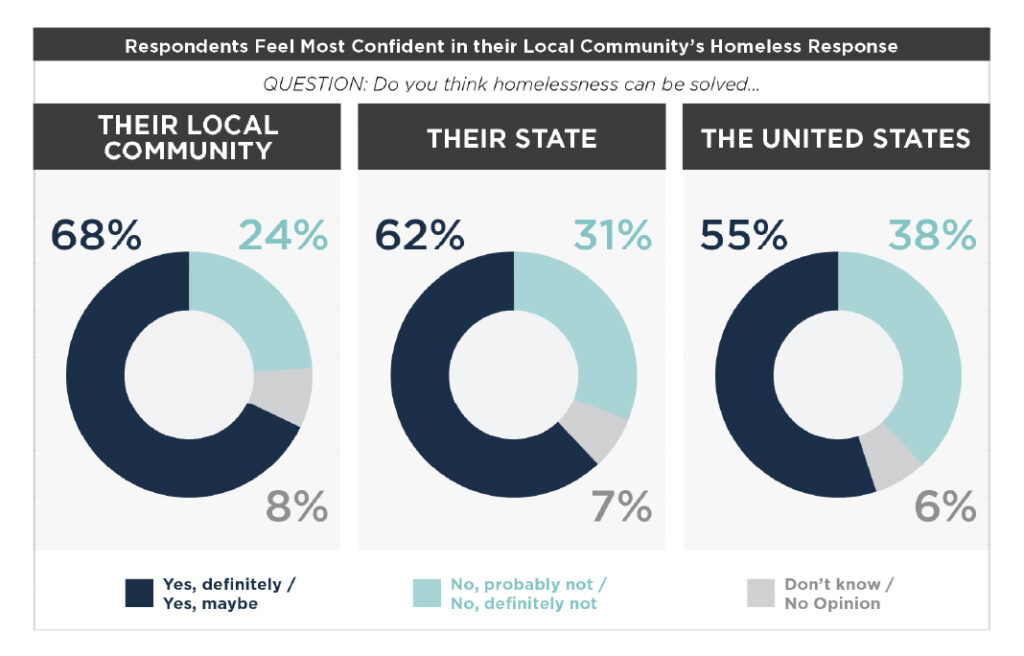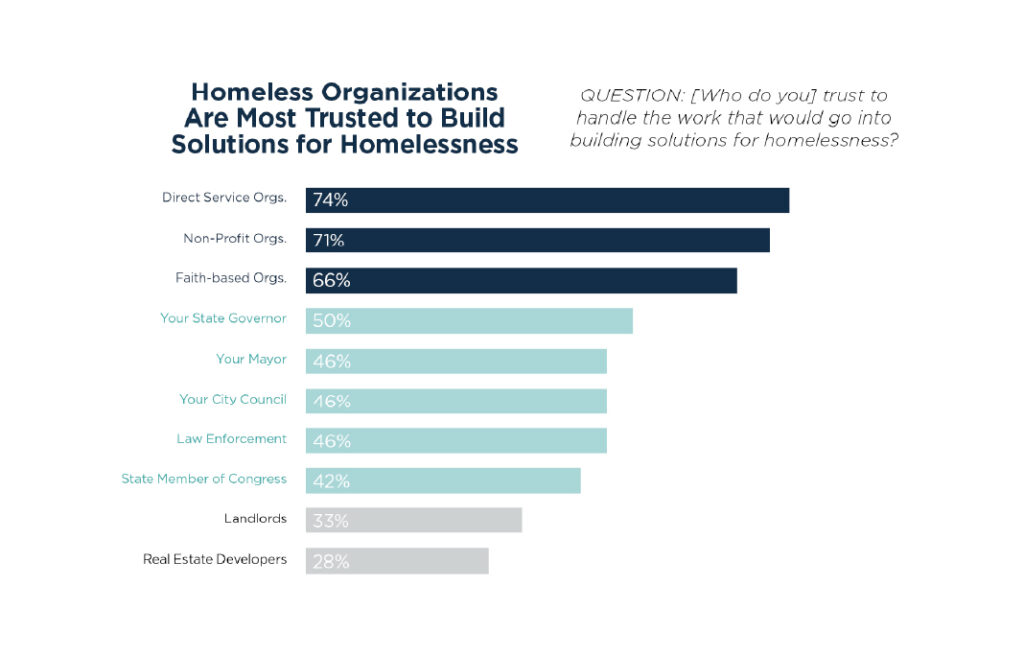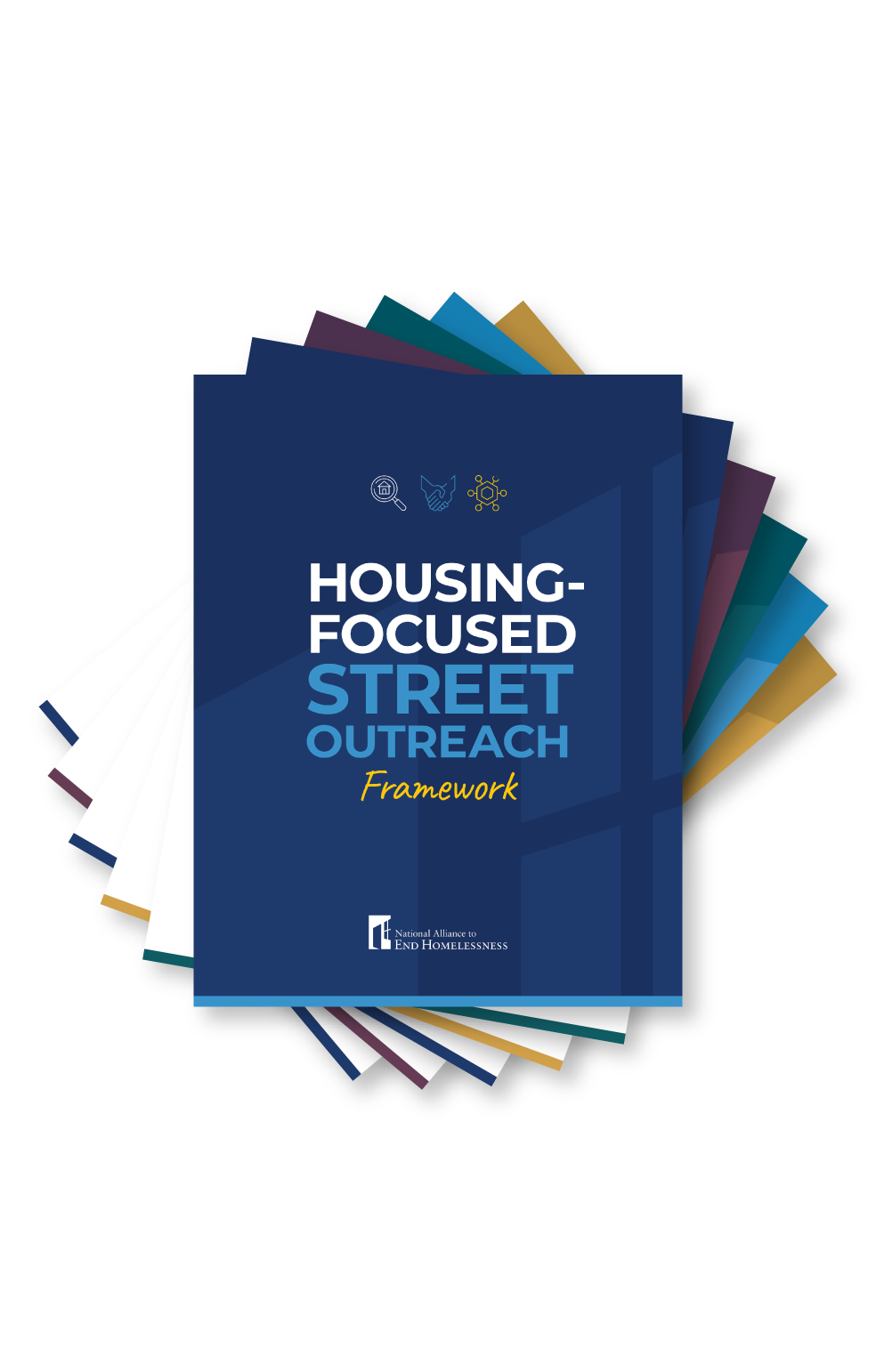Executive Summary
Homelessness in the United States is currently at the highest levels in the history of record keeping by the U.S. Department of Housing and Urban Development. Although extensive research points to the nation’s prolonged affordable housing crisis as the primary driver of this increase, widespread misunderstanding of the causes of and solutions to end homelessness persists among the public.
These gaps in knowledge are impacting efforts to end homelessness in this nation. In recent years, misunderstandings about homelessness have been exploited in an effort to make it a political wedge issue that can divide constituents. The negative consequences are manifold, including a growing sense of cynicism about homelessness, increasing hostility towards people experiencing homelessness, attacks against established best practices for ending people’s homelessness, and increased support for harmful and historically failed carceral tactics that force people into shelter and services under the threat of arrest.
In June 2024, the National Alliance to End Homelessness commissioned Morning Consult to conduct a national public opinion poll to learn about the public’s attitudes and understanding of the homelessness crisis. The objective of this research was to identify areas of support, as well as gaps in awareness and understanding, regarding efforts to address the homelessness crisis in the United States. The ultimate goal is to use the findings to craft more effective communications strategies and tactics to support best practices throughout the homelessness field.
This document outlines findings from the following areas:
- The public’s opinions about causes of and solutions to homelessness
- Its confidence in the ability to end homelessness
- Its engagement with and awareness of homelessness
- Its understanding of the homeless services field
Key Findings
People have divergent opinions about the root causes of homelessness.
There is increasing appreciation of the economic drivers of homelessness, including housing costs, inflation, and low wages. However, dominant narratives on drugs, mental health, and personal decisions continue to be entrenched among segments of the public.
- A nearly equal number of total respondents believe that a lack of affordable housing is a primary driver of homelessness (56%), as believe that drugs and alcohol are (57%).
- Similarly, an equal number of total respondents believe that mental illness and inflation are both primary causes of homelessness (52% each).
Unsheltered homelessness is viewed as a chronic and increasing problem.
- A majority of respondents (76%) believe more people are becoming homeless for the first time compared to the past, including 33% who say significantly more people are becoming homeless.
- 45% have noticed an increase in homelessness in their local community over the past year.
Respondents tend to be more concerned about homelessness across the nation and in other parts of their state than in their own communities.
- Fewer than a third of respondents (31%) believe that homelessness is a very serious problem in their local community, while more than two thirds (68%) believe that it is a very serious problem in the United States.
- Similarly, 68% believe that homelessness definitely or might be able to be solved locally, while only 62% believed the same for their state, and 55% for the nation.
Respondents see all levels of government as responsible for solving homelessness.
- More than three-quarters of respondents (75%) agreed with the statement, “homelessness is solvable, but it requires a level of leadership and investments that elected officials are hesitant to make.”
- Respondents expect elected officials at all levels to do more on homelessness, with the greatest focus on governors and Members of Congress (both 74%), city councilmembers (71%), and mayors (68%).
- A majority said homelessness can be solved with government policies that fund programs to provide shelter, services, and housing for people who are homeless (54%), followed by investments in mental health and substance use prevention (47%). Few (14%) believe that increased law enforcement will effectively address the issue.
Most Americans have limited engagement with the issue of homelessness.
Across all surveyed behaviors, the majority of respondents are not actively engaged with homelessness. Of note:
- More than two-thirds (68%) have never volunteered with a homeless services organization.
- Fewer than half (47%) have ever donated to an organization supporting people experiencing homelessness.
- 61% have never actively researched the issue.
People have favorable opinions of organizations that work to serve people experiencing homelessness, and they recognize that these organizations are under-resourced to achieve their missions.
- Nearly three-quarters of respondents (74%) trust the homeless services sector to handle the work of solving homelessness, polling higher than any other entity (including law enforcement, the private sector, and elected officials across all levels of government).
- Most respondents (71%) believe that the field lacks the resources to make the needed impact.
The Public’s Opinions on the Causes of and Solutions to Homelessness
Causes of Homelessness
The polling reinforced a longstanding belief in America that homelessness is caused by personal factors, including alcoholism and drug addiction (57%), mental illness (52%), and personal decisions (36%). However, the polling also found a rising and nearly equal level of awareness about the economic drivers of homelessness. These include the cost and availability of housing (56%), the overall impact of inflation (52%), and low wages (46%).

This represents a significant shift in the public’s understanding of homelessness. It is likely informed by broader concerns and personal experiences about the cost of housing, the cost of living, and inflationary pressures.
More nuanced drivers of homelessness polled significantly lower:
- Only 38% noted the absence of sufficient social safety protections that would prevent people from becoming at risk of homelessness (i.e., rental assistance, food assistance, healthcare coverage and access, childcare, elder care, etc.).
- Only 34% noted the impact of “feeder” systems that dispatch people into homelessness (i.e., the criminal legal, juvenile justice, foster care, healthcare, education, and eldercare systems).
- Only 18% of respondents noted the impact of zoning as a primary driver of homelessness.
These results indicate shifting, but incomplete, knowledge and understanding about what causes homelessness. Greater public education will be necessary to show the “big picture”: to build awareness of and support for increasing public assistance programs for the most vulnerable (specifically rental assistance), the impacts of upstream systems that fail to divert people from homelessness, and the roles of restrictive zoning and land use regulations on a community’s housing inventory.
Furthermore, the fact that respondents recognize that more people are newly entering into homelessness represents an important chance to demonstrate how inflow (the number of people becoming homelessness) is outpacing outflow (the number of people exiting homelessness into permanent housing) both nationally and in their own communities. This also represents an opportunity to leverage local and national data that showcases the historic rates of housing placements achieved by the nation’s homelessness systems, despite the economic headwinds that are forcing even more people into homelessness.
Solutions to Homelessness
Polling participants were asked to rank a series of potential solutions to homelessness. More than half (54%) reported support for government policies that fund programs to provide shelter, services, and housing for people who are homeless, and 47% supported increased investments in mental health and substance use prevention.
Of note, most respondents (86%) did not believe that homelessness could be solved by increased law enforcement to keep people from sleeping outdoors on public property.
Rather, respondents expect elected officials to be most accountable for doing more to address homelessness. When provided with a list of public, private, and non-profit entities and asked who was most responsible for ending homelessness in their communities, people were most likely to name the federal government (20%), followed by their state’s governor (15%) and organizations serving the homeless (11%). Few respondents named for-profit entities, such as landlords (6%) or real estate developers (2%).
Similarly, when asked who should be doing more to build solutions for building solutions to homelessness in their community respondents firmly elected officials most responsible, with governors and members of Congress each polling at 75%, city council members at 71%, and mayors at 68%.
Cumulatively, these responses reflect a challenging disconnect between the solutions that the public supports and those offered by many of their elected leaders. For example, respondents report that they are more likely to support shelter, services, and housing than they are to support increased law enforcement to address homelessness. Yet, state laws and local ballot measures increasingly call for greater law enforcement responses to homelessness, and these frequently enjoy more public support than the polling responses suggest. Moreover, the siting of housing and shelter facilities is consistently met with local opposition, which would seem to contradict support for these solutions.
These results indicate a need for greater advocacy in support of long-term solutions. To capitalize on these findings, it will be urgent for providers and homeless systems leaders to build out far more robust federal, state, and local advocacy infrastructure for appealing to lawmakers. For example:
- Respondents voiced similar levels of support for housing and shelter as they did for mental health and substance use treatment. It is crucial that advocates more explicitly establish the linkage of permanent housing and wraparound services for people experiencing homelessness. Without making these connections, lawmakers and members of the public may embrace oversimplified narratives that supportive housing does not include services, such as physical and mental healthcare, drug and alcohol treatment, and job training.
- Similarly, when state and local lawmakers propose carceral responses to homelessness, it will be essential for advocates to demonstrate that their constituents are seeking bolder leadership. All levels of government must act to advance real long-term solutions, and to highlight the failure of law enforcement tactics to actually end people’s homelessness.
The Public’s Confidence in Ending Homelessness
Respondents were offered a series of statements about solutions to homelessness. Although a variety of perspectives emerged in these responses, there was notable confidence that elected officials could solve homelessness with the appropriate policies and political will.
Overall, 75% of respondents either strongly or somewhat agreed with the statement, “Homelessness is solvable, but it requires a level of leadership and investment that our elected officials are hesitant to make.”
Similarly, 70% of respondents strongly or somewhat agreed with the statement, “Homelessness is caused by social and economic policies that leave people economically vulnerable and without the supports to live stably. It can be solved by policies that better protect vulnerable people.”
However, a nearly equal number of respondents (68%) expressed a resignation that homelessness is an inevitable aspect of modern times, agreeing with the statement, “There have always been homeless people and there will always be homeless people. Instead of talking about ending homelessness, we need to find alternatives to people sleeping in tents in public.”
Of note, there was less support for more pessimistic statements. Less than half of respondents (47%) agreed with the statement, “If people don’t want to help themselves, we can’t/shouldn’t help them.”
These responses make it clear that the public is eager for solutions. However, support for economic protections should not be considered a mandate from the public; 48% of respondents expressed impatience and a desire to see faster progress on homelessness. Meeting both demands will require sophisticated advocacy, as support for short-term tactics is often at the expense of longer-term social safety net investments.
Local vs State and National Perspectives
Although respondents believe that they are seeing an increase in unsheltered homelessness in their communities (45%) and that more people in their communities are becoming homeless for the first time (76%), they also reflected greater confidence in solving homelessness on the local level than in their states or across the nation.
More than two thirds of respondents (68%) believe that homelessness could be solved in their local community.
Slightly less than two thirds of respondents (62%) believe the same for their state (22% responding “definitely yes,” and 40% responding “maybe yes”).
Only 55% responded that homelessness could be solved in the nation (23% responding “definitely yes,” and 32% responding “maybe yes”).
These responses suggest that dominant narratives have taken root about the intractable severity of homelessness in the nation’s large urban areas. However, they also reflect confidence in local systems and providers to appropriately address this issue and a desire for greater accountability among local elected officials. To capitalize on this, homelessness system leaders and providers must do as much as possible to publicly reinforce their central role in their community’s homelessness response.

The Public’s Engagement with and Awareness of Homelessness
Generally, most respondents have limited knowledge of and engagement with homelessness. Even though two-thirds (67%) had seen, read, or heard “some or a lot about homelessness” over the past six months, fewer than half had a connection to the issue across surveyed behaviors.
Fewer than half (47%) have ever donated to an organization supporting people experiencing homelessness.
61% have never actively researched the issue.
More than two thirds (68%) have never volunteered with a homeless services organization.
85% have never contacted a lawmaker about an initiative to support homeless individuals in their community.
There are several factors that may affect these figures, including a pronounced reduction in both individual donations and volunteerism since the onset of the COVID-19 pandemic. (These are national trends, not specific to homeless services organizations; however, it is noteworthy that the response rate for volunteerism is approximately 9% higher than the national average; while donation rates are 22% lower). Nonetheless, much like “low information voters” during elections, a lack of engagement could make people vulnerable to misinformation, more prone to adopt assumptions or harmful narratives about homelessness, and more likely to have their support for best practices eroded.
This underscores the critical need for homeless service providers, system leaders, and advocates to boost their communication and engagement with members of their communities. It represents an essential opportunity for providers to better identify opportunities for their neighbors to have a role in their work; and to better educate them about their efforts in the community, their needs and obstacles, and the impact they make.
Public Opinions on the Homeless Services Sector
Respondents demonstrated strong support for the homeless services sector, coupled with some important gaps in understanding the sector’s work.
Overall, the sector is viewed as trustworthy. When provided with a list of entities who might be tasked with ending homelessness, 74% of respondents said that homeless system providers were most trusted to do this work – significantly above faith-based organizations, elected officials at all levels, law enforcement officers, and real estate developers. These results were consistent across all segmented populations.
When asked which qualities best applied to the sector, respondents were most likely to describe the field as under-resourced and compassionate (both polling at 48%). This was reinforced by the number of respondents (71%) who believed that the sector is trying to make a difference, but lacks the resources needed to make an impact.

However, the findings also showed some doubts about the sector’s effectiveness, with 67% of respondents believing that organizations serving people experiencing homelessness are sometimes effective, but sometimes not. And while 62% of respondents say that they have either “a lot” or “some” confidence in the sector, approximately half (51%) expressed support for only funding organizations if they are reducing homelessness in their communities.
These findings point to a contradictory perception of the field among the public: people broadly trust the sector and they understand that their efforts are hamstrung by underfunding, yet they also support withholding funds if homelessness is not reduced. This is a concerning example of how the field must do more to demonstrate its outcomes, while also illustrating the downward economic pressures that are driving people into homelessness in record numbers.
Moreover, the qualities associated with the field, while generally positive and sympathetic, do not adequately capture the strategic or data-driven nature of its work, nor does it account for the impact that providers make in their communities. As such, it likens the homeless services sector as more akin to charity than as the cornerstone of a community’s homelessness response. Correcting this perception will be critical for boosting the field’s credibility, strengthening advocacy for greater resources, and building support for its efforts.
Conclusion
These survey responses reinforce our understanding that homelessness is complex, and that most members of the public have limited engagement and understanding of the issue. Although respondents are generally supportive of the sector’s work, they are also concerned and impatient about the worsening crisis. This can cause people to support short term and/or harmful measures, even if they have expressed support for long-term investments in needed housing, shelter, and services.
Moving forward, there is a clear and urgent need for enhanced advocacy and communications support throughout the sector. This will be critically important for better educating the public on homelessness, uplifting the value and the impact of the field’s work, educating the public about the economic headwinds that slow progress on reducing homelessness, and boosting access to the resources the field critically needs to accomplish its efforts.
Methodology
Polling was conducted by Morning Consult between May 31 – June 4, 2024, among a sample of 4,049 adults, with an estimated 10 – 15 minute timeframe for completion (not including demographic questions). Data were weighted to approximate a target sample of adults based on age, gender, race, educational attainment, region, gender by age, and race by educational attainment. Results from the full survey have a margin of error of plus or minus 2 percentage points.
Interested in
learning more?
Subscribe today to stay informed and get regular updates from the Alliance.











